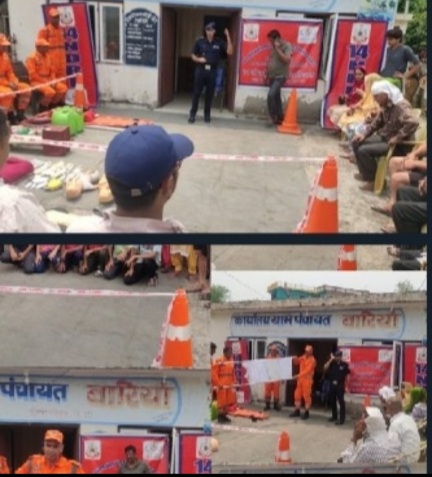SHIMLA: In a bid to gear up for any emergency situations, the 14 NDRF team rolled out a comprehensive training program at Village Bariyan in Nalagarh, Himachal Pradesh.
The team showcased an array of rescue techniques aimed at equipping locals with essential life-saving skills.
During the program, residents were taught crucial first aid measures, including CPR and how to handle choking incidents (FBAO).
The NDRF team also demonstrated effective methods to control bleeding, and ways to safely lift and move injured individuals.
NDRF also showed how to create improvised stretchers and floating devices using everyday materials.
A significant part of the training was dedicated to educating people about what to do and what to avoid during a heat stroke, ensuring they are prepared for such emergencies.
Here is what you need to do what NDR tries to teach and train you:
How CPR (Cardiopulmonary Resuscitation) is Done:
1. Check Responsiveness and Breathing:
- Tap the person and shout to see if they respond.
- Check if they are breathing normally.
2. Call for Help:
- If there’s no response and the person isn’t breathing normally, call emergency services.
3. Begin Chest Compressions:
- Place the heel of one hand on the center of the chest, right between the nipples.
- Place your other hand on top and interlock your fingers.
- Keep your arms straight and shoulders directly over your hands.
- Press down hard and fast, at least 2 inches deep, at a rate of 100-120 compressions per minute.
4. Provide Rescue Breaths (if trained and willing):
- Tilt the person's head back and lift the chin to open the airway.
- Pinch the nose shut and cover their mouth with yours, forming a seal.
- Give two breaths, each lasting about one second, watching for the chest to rise.
- Continue with cycles of 30 chest compressions and 2 rescue breaths until help arrives or the person starts breathing.
How FBAO (Foreign Body Airway Obstruction) is Handled:
1. Assess the Situation:
- Ask if the person is choking. If they can’t speak, cough, or breathe, it’s a severe obstruction.
2. Give Back Blows (for conscious individuals):
- Stand to the side and slightly behind the person.
- Support their chest with one hand and lean them forward.
- Deliver 5 firm back blows between the shoulder blades with the heel of your hand.
3. Perform Abdominal Thrusts (Heimlich Maneuver):
- Stand behind the person and wrap your arms around their waist.
- Make a fist with one hand and place it just above their navel.
- Grasp your fist with the other hand and give quick, upward thrusts.
- Repeat back blows and abdominal thrusts until the object is expelled or the person becomes unresponsive.
4. For Unresponsive Individuals:
- Lower them to the ground and start CPR. Each time you open the airway to give breaths, look for the object.
How Bleeding is Controlled:
1. Apply Pressure
- Use a clean cloth or bandage to press directly on the wound.
- Maintain steady, firm pressure until the bleeding slows or stops.
2. Elevate the Wound:
- If possible, raise the injured area above the level of the heart to reduce blood flow to the area.
3. Apply a Tourniquet (if severe bleeding and trained to use):
- Place a tourniquet around the limb, above the bleeding site.
- Tighten it until the bleeding stops and note the time of application.
4. Use Hemostatic Dressings(if available and trained to use):
- These dressings help to clot the blood faster and can be applied directly to the wound.
5. Keep the Person Calm and Still:
- Encourage them to stay still to prevent increasing their heart rate and blood flow, which could worsen the bleeding.
6. Seek Professional Help;
- Continue to apply pressure and seek emergency medical assistance as soon as possible.
This initiative by the NDRF is a step towards creating a more resilient and well-prepared community, ready to tackle any unforeseen disasters with confidence and skill.










